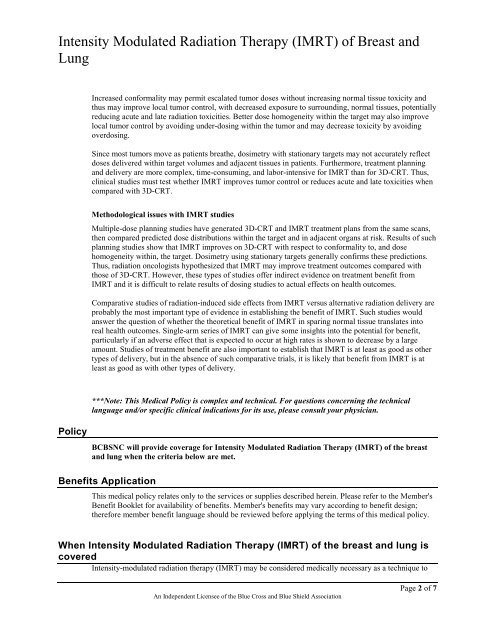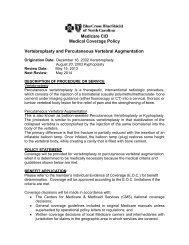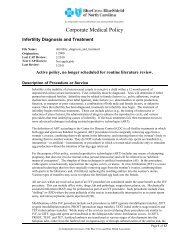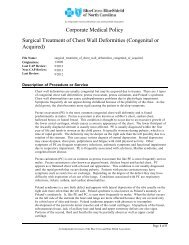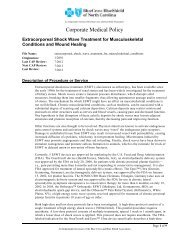Intensity Modulated Radiation Therapy (IMRT) of Breast and Lung
Intensity Modulated Radiation Therapy (IMRT) of Breast and Lung
Intensity Modulated Radiation Therapy (IMRT) of Breast and Lung
Create successful ePaper yourself
Turn your PDF publications into a flip-book with our unique Google optimized e-Paper software.
<strong>Intensity</strong> <strong>Modulated</strong> <strong>Radiation</strong> <strong>Therapy</strong> (<strong>IMRT</strong>) <strong>of</strong> <strong>Breast</strong> <strong>and</strong><br />
<strong>Lung</strong><br />
Policy<br />
Increased conformality may permit escalated tumor doses without increasing normal tissue toxicity <strong>and</strong><br />
thus may improve local tumor control, with decreased exposure to surrounding, normal tissues, potentially<br />
reducing acute <strong>and</strong> late radiation toxicities. Better dose homogeneity within the target may also improve<br />
local tumor control by avoiding under-dosing within the tumor <strong>and</strong> may decrease toxicity by avoiding<br />
overdosing.<br />
Since most tumors move as patients breathe, dosimetry with stationary targets may not accurately reflect<br />
doses delivered within target volumes <strong>and</strong> adjacent tissues in patients. Furthermore, treatment planning<br />
<strong>and</strong> delivery are more complex, time-consuming, <strong>and</strong> labor-intensive for <strong>IMRT</strong> than for 3D-CRT. Thus,<br />
clinical studies must test whether <strong>IMRT</strong> improves tumor control or reduces acute <strong>and</strong> late toxicities when<br />
compared with 3D-CRT.<br />
Methodological issues with <strong>IMRT</strong> studies<br />
Multiple-dose planning studies have generated 3D-CRT <strong>and</strong> <strong>IMRT</strong> treatment plans from the same scans,<br />
then compared predicted dose distributions within the target <strong>and</strong> in adjacent organs at risk. Results <strong>of</strong> such<br />
planning studies show that <strong>IMRT</strong> improves on 3D-CRT with respect to conformality to, <strong>and</strong> dose<br />
homogeneity within, the target. Dosimetry using stationary targets generally confirms these predictions.<br />
Thus, radiation oncologists hypothesized that <strong>IMRT</strong> may improve treatment outcomes compared with<br />
those <strong>of</strong> 3D-CRT. However, these types <strong>of</strong> studies <strong>of</strong>fer indirect evidence on treatment benefit from<br />
<strong>IMRT</strong> <strong>and</strong> it is difficult to relate results <strong>of</strong> dosing studies to actual effects on health outcomes.<br />
Comparative studies <strong>of</strong> radiation-induced side effects from <strong>IMRT</strong> versus alternative radiation delivery are<br />
probably the most important type <strong>of</strong> evidence in establishing the benefit <strong>of</strong> <strong>IMRT</strong>. Such studies would<br />
answer the question <strong>of</strong> whether the theoretical benefit <strong>of</strong> <strong>IMRT</strong> in sparing normal tissue translates into<br />
real health outcomes. Single-arm series <strong>of</strong> <strong>IMRT</strong> can give some insights into the potential for benefit,<br />
particularly if an adverse effect that is expected to occur at high rates is shown to decrease by a large<br />
amount. Studies <strong>of</strong> treatment benefit are also important to establish that <strong>IMRT</strong> is at least as good as other<br />
types <strong>of</strong> delivery, but in the absence <strong>of</strong> such comparative trials, it is likely that benefit from <strong>IMRT</strong> is at<br />
least as good as with other types <strong>of</strong> delivery.<br />
***Note: This Medical Policy is complex <strong>and</strong> technical. For questions concerning the technical<br />
language <strong>and</strong>/or specific clinical indications for its use, please consult your physician.<br />
BCBSNC will provide coverage for <strong>Intensity</strong> <strong>Modulated</strong> <strong>Radiation</strong> <strong>Therapy</strong> (<strong>IMRT</strong>) <strong>of</strong> the breast<br />
<strong>and</strong> lung when the criteria below are met.<br />
Benefits Application<br />
This medical policy relates only to the services or supplies described herein. Please refer to the Member's<br />
Benefit Booklet for availability <strong>of</strong> benefits. Member's benefits may vary according to benefit design;<br />
therefore member benefit language should be reviewed before applying the terms <strong>of</strong> this medical policy.<br />
When <strong>Intensity</strong> <strong>Modulated</strong> <strong>Radiation</strong> <strong>Therapy</strong> (<strong>IMRT</strong>) <strong>of</strong> the breast <strong>and</strong> lung is<br />
covered<br />
<strong>Intensity</strong>-modulated radiation therapy (<strong>IMRT</strong>) may be considered medically necessary as a technique to<br />
An Independent Licensee <strong>of</strong> the Blue Cross <strong>and</strong> Blue Shield Association<br />
Page 2 <strong>of</strong> 7


